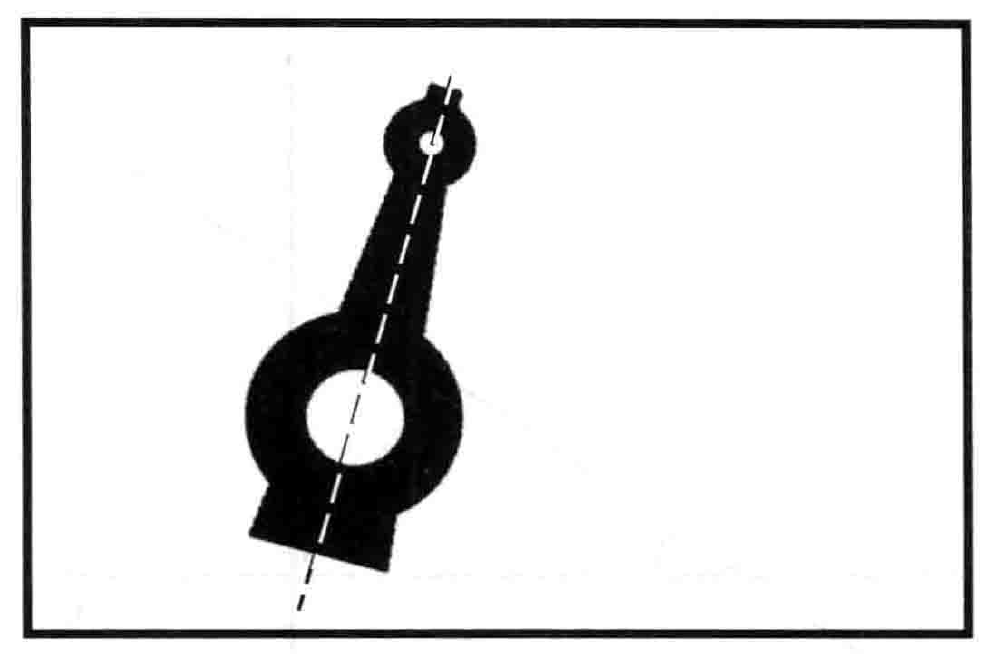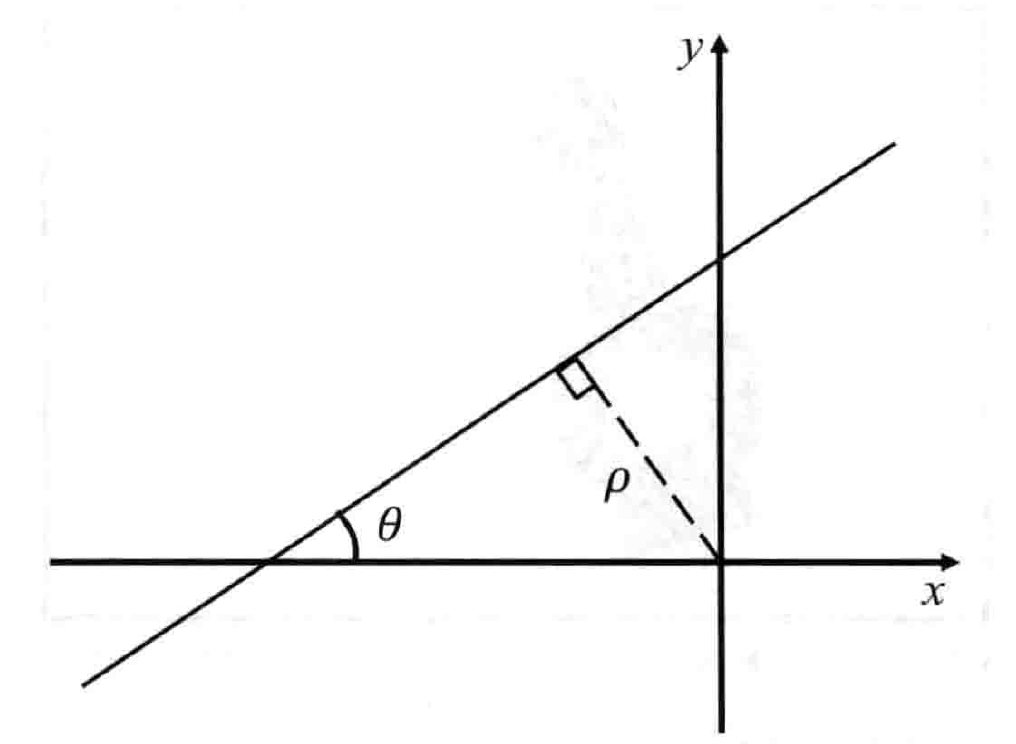本文最后更新于:2024年1月14日 晚上
本文记录《机器视觉》 第三章第二节 —— 简单几何性质,一些学习笔记和个人理解,其中核心内容为二值图的转动惯量求解。
我们已经有了一组二值图,我们可以根据二值图来确定其表示物体的简单几何性质。
特征函数
二值图的特征函数 $b(x, y)$比较简单,当$[x, y]$处有物体时值为1,否则为0
面积
$$
A=\iint_{I} b(x, y) d x d y \tag{1}
$$
可以认为是二值图的 0 阶矩的物理意义。
质心

空间位置按照密度加权平均即是质心的位置 $ (\bar{x}, \bar{y}) $:
$$
\bar{x} \iint _ { I } b ( x , y ) d x d y = \iint _ { I } x b ( x , y ) d x d y \tag{2}
$$
$$
\bar { y } \iint _ { I } b ( x , y ) d x d y = \iint _ { I } y b ( x , y ) d x d y\tag{3}
$$
可以认为是二值图的 1 阶矩(静力矩)物理意义。
朝向

-
如果我们想要知道二值图物体表示的朝向,则需要用到转动惯量的概念。如果找到了使得物体转动惯量最小的轴,那么这个轴向就是物体的朝向。
-
在当前图像为二维的情况下,转动惯量是物体针对某条直线,将物体上的每个点到直线距离的平方按照密度计算积分,即得到了图像关于该轴向的转动惯量值。
-
我们的任务是为给定的二值图物体找到使得其转动惯量最小的直线。
-
转动惯量计算方法:
$$
E=\iint_{I} r^{2} b(x, y) d x d y \tag{4} \label{4}
$$
- 其中 $r$ 表示二值图上的点到直线的距离,虽然还没有这条直线
直线建模

-
为我们的目标直线建模,取2个参数
- 原点到直线的距离 $\rho$
- 直线和 $x$ 轴之间(沿逆时针方向)的夹角 $\theta$
-
这种建模方式有一些方便之处:
- 当坐标系平移或旋转时,这两个参数的变化是连续的
- 当直线平行(或近似平行)于某个坐标轴时,用这两个参数来表示直线也不会产生问题(相比于:使用斜率和截距来表示直线的情况)
-
使用这两个参数,可以将直线方程写为如下形式:
$$
x \sin \theta-y \cos \theta+\rho=0 \tag{5} \label{5}
$$
- 在直线上,距离原点最近的点$ (-\rho \sin \theta,+\rho \cos \theta) $,通过这个点,沿着夹角 $\theta$ 运动任意距离$s$ 的点仍在直线上,因此可以将直线上任意一点$(x_0,y_0)$表示为:
$$
\begin{array} { l } { x _ {0 } = - \rho \sin \theta + s \cos \theta } \\ { y _ {0} = + \rho \cos \theta + s \sin \theta } \end{array} \tag{6} \label{6}
$$
最短距离
- 回到我们的二值图,在给定直线方程的情况下,二值图上一点$(x,y)$,直线上距离其最近的点$(x_0,y_0)$,二者距离显然可以表示为:
$$
r^{2}=\left(x-x_{0}\right)^{2}+\left(y-y_{0}\right)^{2} \tag{7} \label{7}
$$
$$
r^{2}=x^{2}+y^{2}+\rho^{2}+2 \rho(x \sin \theta-y \cos \theta)-2 s(x \cos \theta+y \sin \theta)+s^{2} \tag{8} \label{8}
$$
- 对于每个点,我们都需要解$\eqref{8}$这样的优化方程
- 即给定了$x,y,\rho,\theta$,求解使得$r$最小的s$,我们在$$\eqref{8}$中对$s$求导,可得:
$$
s=x \cos \theta+y \sin \theta \tag{9} \label{9}
$$
- 将$\eqref{9}$带入$\eqref{6}$,二值图上$(x,y)$到直线上距离最近的点$(x_0,y_0)$可得到关系为:
$$
x-x_{0}=+\sin \theta(x \sin \theta-y \cos \theta+\rho) \\
y-y_{0}=-\cos \theta(x \sin \theta-y \cos \theta+\rho) \tag{10} \label{10}
$$
- 将$\eqref{10}$带入 $\eqref{7}$可得:
$$
r^{2}=(x \sin \theta-y \cos \theta+\rho)^{2} \tag{11} \label{11}
$$
- 此处可以看到,将某点$(x,y)$带入$\eqref{5}$,得到值的绝对值即为该点到直线的垂线(最短)距离。
二阶矩轴向通过质心
- 我们已经得到了二值图上一点到任意直线的距离计算方法,将$\eqref{11}$带入$\eqref{4}$,得到:
$$
\begin{aligned}
E&=\iint_{I}(x \sin \theta-y \cos \theta+\rho)^{2} b(x, y) d x d y \\
&=\iint_{I}[{(x\sin \theta - y\cos \theta )^2} + {\rho ^2} + 2\rho (x\sin \theta - y\cos \theta )]b(x,y)dxdy\\
&=[{(x\sin \theta - y\cos \theta )^2} + {\rho ^2}]\iint_{I}b(x,y)dxdy + 2\rho \sin \theta \iint_{I}xb(x,y)dxdy - 2\rho \cos \theta \iint_{I}{yb(x,y)dxdy}
\end{aligned}
\tag{12}
$$
$$
(\bar{x} \sin \theta-\bar{y} \cos \theta+\rho) A=0\tag{13}
$$
- 其中,A是区域面积,而是区域质心。因此,我们得到了结论:
$$
最小二阶矩所对应的轴一定经过区域重心!
$$
确定轴向倾角
我们已经确定该轴经过一个确定的点$ (\bar{x}, \bar{y}) $了,仅需要再确定直线倾角即可。
- 将二值图平移到原点与质心重合的位置,那么我们要求得的就是一条穿过原点的直接倾角
- 也就是直接去除 $\rho$ 参数的影响
- 转动惯量计算方式如下:
$$
E=\iint_{I}(x’ \sin \theta-y’ \cos \theta)^{2} b(x’, y’) d x’ d y’ \tag{14}
$$
其中,我们定义平移后的二值图$I’$上点的坐标为$ ({x’}, {y’}) $。
$$
\begin{array}{l}
E=a \sin ^{2} \theta-b \sin \theta \cos \theta+c \cos ^{2} \theta \\
其中:
a=\iint_{I^{\prime}}\left(x^{\prime}\right)^{2} b\left(x^{\prime}, y^{\prime}\right) d x^{\prime} d y^{\prime} \\
b=2 \iint_{I^{\prime}}\left(x^{\prime} y^{\prime}\right) b\left(x^{\prime}, y^{\prime}\right) d x^{\prime} d y^{\prime} \\
c=\iint_{I^{\prime}}\left(y^{\prime}\right)^{2} b\left(x^{\prime}, y^{\prime}\right) d x^{\prime} d y^{\prime} \\
\end{array}
\tag{15}
\label{15}
$$
$$
E=\frac{1}{2}(a+c)-\frac{1}{2}(a-c) \cos 2 \theta-\frac{1}{2} b \sin 2 \theta \tag{16}
$$
- 上式对$\theta$求导,并令求导结果等于零
- 假设$a≠c$,我们可以得到:
$$
\tan 2 \theta=\frac{b}{a-c} \tag{17} \label{17}
$$
- 因此除非出现$ b=0 $ 并且 $ a=c $ 的情况, 否则, 我们最终可以得到:
$$
\begin{array}{l}
\sin 2 \theta=\pm \frac{b}{\sqrt{b^{2}+(a-c)^{2}}} \quad \\ \cos 2 \theta=\pm \frac{a-c}{\sqrt{b^{2}+(a-c)^{2}}}
\end{array}
\tag{18}
$$
- 至此我们已经求出了使得该二值图转动惯量最小和最大的两个轴
- $E$ 的的最小值和最大值的比值,给出了一些关于物体有“多么圆”的信息。对于直线,这个比值是0对于圆,这个比值是1。
拉格朗日
从式$\eqref{15}$开始,事实上我们要解的就是一个带约束的优化方程组,可以使用拉格朗日乘数法求解:
$$
\begin{array}{l}
E = a{x^2} - bxy + c{y^2}\\
s.t.{x^2} + {y^2}-1 = 0
\end{array} \tag{19} \label{19}
$$
- 将$E$设为$f(x,y)$,约束条件设为$g(x,y)=0$,构建拉格朗日方程:
$$
L(x,y) = a{x^2} - bxy + c{y^2} + \lambda ({x^2} + {y^2}-1) \tag{20}
$$
$$
\left\{ \begin{array}{l}
\frac{{\partial f}}{{\partial x}} + \lambda \frac{{\partial g}}{{\partial x}} = 0\\
\frac{{\partial f}}{{\partial y}} + \lambda \frac{{\partial g}}{{\partial y}} = 0\\
g(x,y) = 0
\end{array} \right. \to \left\{ \begin{array}{l}
2ax - by + 2\lambda x = 0\\
2{\rm{cy}} - bx + 2\lambda y = 0\\
{x^2} + {y^2} = 1
\end{array} \right. \tag{21}
$$
- 重新令 $x = sin\theta, y=cos \theta$ 可得:
$$
\begin{array}{l}
2a - b\frac{1}{{\tan \theta }} = 2c - b\tan \theta \\
b(ta{n^2}\theta - 1) + 2(a - c)tan\theta = 0\\
\frac{b}{{a - c}} = \frac{{2\tan \theta }}{{{{\tan }^2}\theta - 1}} = \tan 2\theta
\end{array} \tag{22}
$$
特征向量
可以将$\eqref{19}$看作是一个二次型优化问题,原带约束的方程可以写成:
$$
\begin{array}{*{20}{l}}
{E = {{\bf{s}}^T}{\bf{As}}}\\
{s.t.1-{{\bf{s}}^T}{\bf{Is}} = 0}
\end{array} \tag{23}
$$
- 其中: ${\bf{s}} = \left( \begin{array}{l}
x\\
y
\end{array} \right)$,${\bf{A}} = \left( \begin{array}{l}
\begin{array}{*{20}{c}}
a&{\frac{b}{2}}
\end{array}\\
\begin{array}{*{20}{c}}
{\frac{b}{2}}&c
\end{array}
\end{array} \right)$,$\bf{I}$为二阶单位阵
- 那么拉格朗日方程可以写成:
$$
{L = {{\bf{s}}^T}{\bf{As}} - \lambda(1- {{\bf{s}}^T}{\bf{Is}}}) \tag{24}
$$
$$
\begin{array}{l}
\frac{{\partial L}}{{\partial {\bf{s}}}} = 2{\bf{As}} - 2\lambda {\bf{Is}} = 0\\
{\bf{As}} = \lambda {\bf{s}}
\end{array} \tag{25} \label{25}
$$
- 而式$\eqref{25}$就是在寻找矩阵$\bf{A}$的特征向量和特征值。
- 也就是说,对于给定的二值图,求解其对应的$a,b,c$,构造出矩阵$\bf{A}$,求解$\bf{A}$的特征向量即是寻找最大、最小转动惯量的方向。
- 二者大小的比值也类似于特征值的比值,也就是矩阵的条件数。
参考示例

1
2
3
4
5
6
7
8
9
10
11
12
13
14
15
16
17
18
19
20
21
22
23
24
25
26
27
28
29
30
31
32
33
34
35
36
37
38
39
40
41
42
43
44
45
46
47
48
49
50
51
52
53
54
55
56
57
58
59
60
61
62
63
64
65
66
67
68
69
70
71
72
73
74
75
76
77
78
79
80
81
82
83
84
| import math
import cv2
import numpy as np
import matplotlib.pyplot as plt
from numpy.lib.function_base import iterable
def vvd_round(num):
if iterable(num):
return np.round(np.array(num)).astype('int32').tolist()
return int(round(num))
def show_image(image):
plt.imshow(image.astype('uint8'))
plt.show()
pass
def gravity_center(mask):
Ys, Xs = mask.nonzero()
A = (mask > 0).sum()
C_X = (Xs).sum() / A
C_Y = (Ys).sum() / A
return C_X, C_Y
def load_gray_image(image_path):
image = cv2.imread(image_path)
image = cv2.cvtColor(image, cv2.COLOR_BGR2GRAY)
image = (image == 0).astype('uint8') * 255
return image
def moment_of_inertia(mask, center):
temp_image = mask.copy().astype('uint8') * 128
C_X, C_Y = center
Ys, Xs = mask.nonzero()
Ys = (Ys - C_Y) / 100
Xs = (Xs - C_X) / 100
a = (Xs * Xs).sum()
b = 2 * (Xs * Ys).sum()
c = (Ys * Ys).sum()
if b == 0:
theta = 0
elif a == c:
theta = - np.pi * 0.5 * 0.5
else:
theta = - math.atan(b / (a - c)) / 2
point_1 = vvd_round([C_X + math.cos(theta) * 200, C_Y - math.sin(theta) * 200])
point_2 = vvd_round([C_X - math.cos(theta) * 200, C_Y + math.sin(theta) * 200])
temp_image = cv2.line(temp_image.astype('uint8'), point_1, point_2, 255, 2)
point_1 = vvd_round([C_X + math.cos(theta + 0.5 * np.pi) * 200, C_Y - math.sin(theta + 0.5 * np.pi) * 200])
point_2 = vvd_round([C_X - math.cos(theta + 0.5 * np.pi) * 200, C_Y + math.sin(theta + 0.5 * np.pi) * 200])
temp_image = cv2.line(temp_image.astype('uint8'), point_1, point_2, 200, 2)
theta_1 = theta
theta_2 = theta + 0.5 * np.pi
E_1 =(math.sin(theta_1)) ** 2 * a - b * math.sin(theta_1) * math.cos(theta_1) + c * (math.cos(theta_1)) ** 2
E_2 =(math.sin(theta_2)) ** 2 * a - b * math.sin(theta_2) * math.cos(theta_2) + c * (math.cos(theta_2)) ** 2
return temp_image, min(E_2, E_1) / max(E_2, E_1, 1)
if __name__ == '__main__':
image_path = 'test.png'
image = load_gray_image(image_path)
center = gravity_center(image)
temp_image, rate = moment_of_inertia(image, center)
show_image(temp_image)
pass
|

参考资料
- 伯特霍尔德・霍恩著BERTHOLDKLAUSPAULHORN. 机器视觉[M]. 中国青年出版社, 2014.
文章链接:
https://www.zywvvd.com/notes/study/image-processing/robot-vision/chapter-3/binary-image-moment/binary-image-moment/






